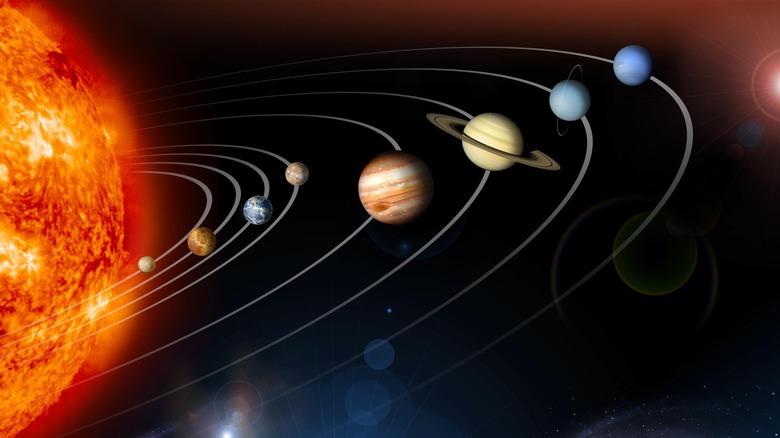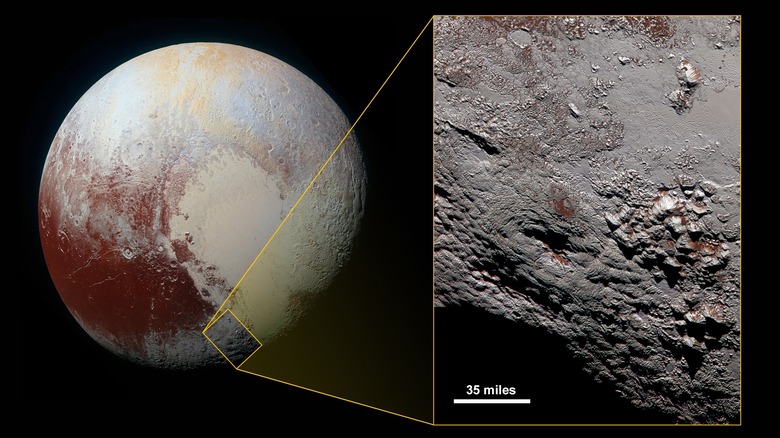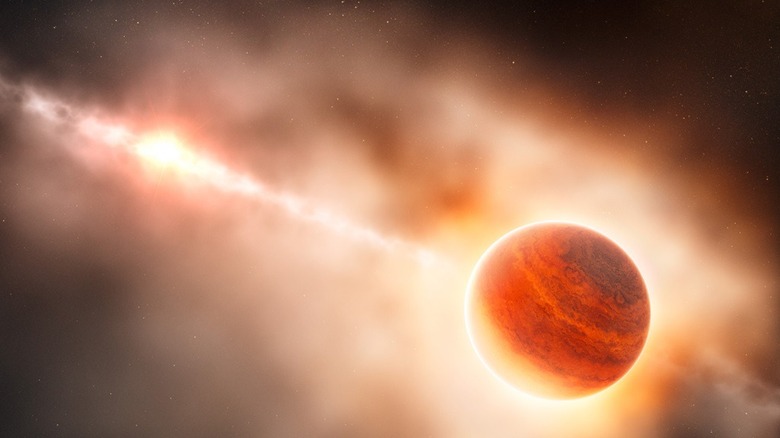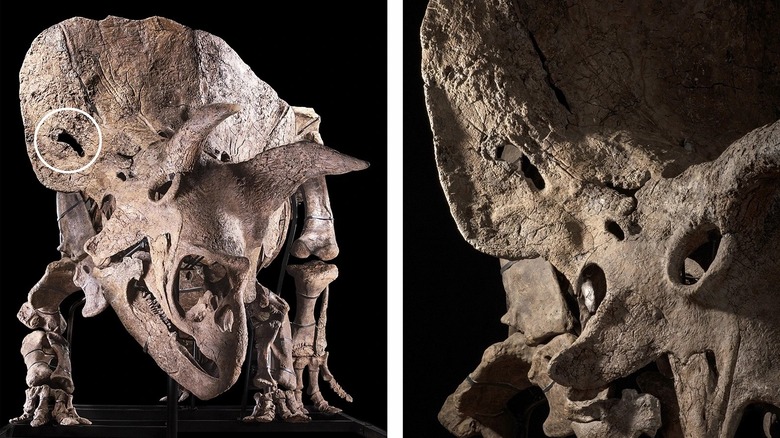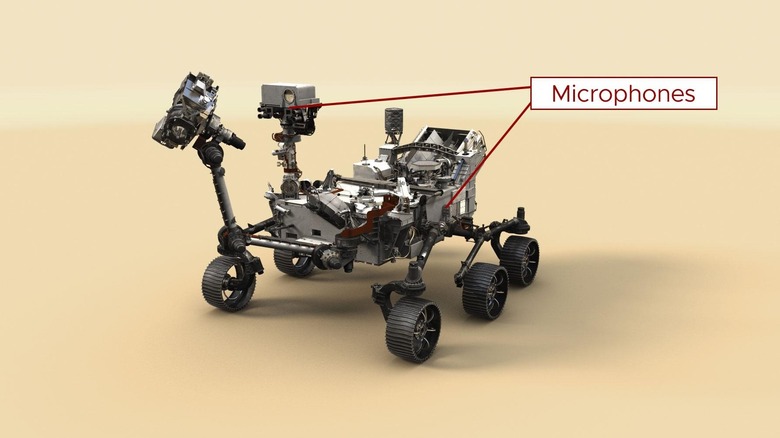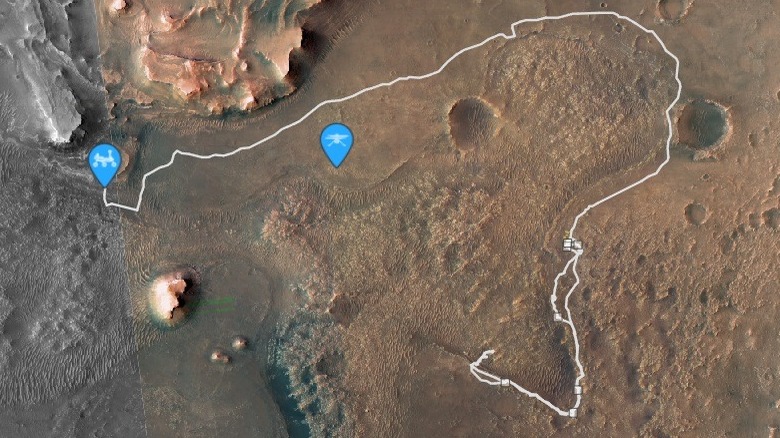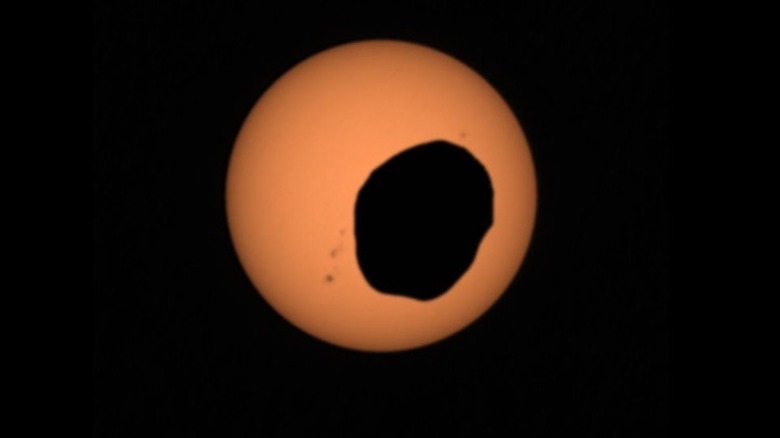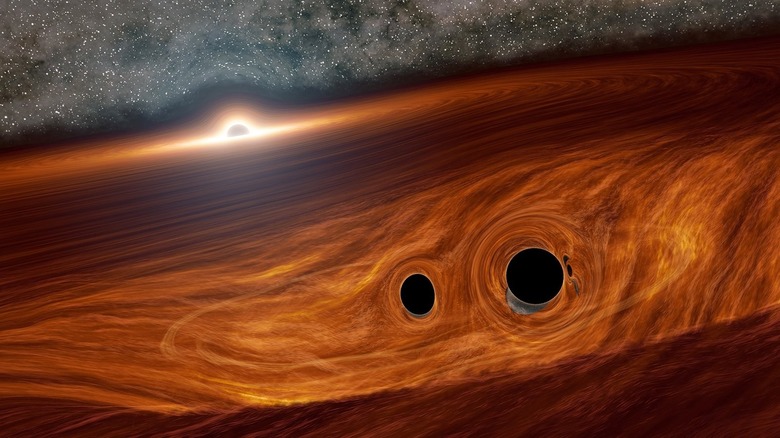The 12 Coolest Scientific Discoveries Of April 2022
Did you know that in the last month — as with all months — scientists, researchers, and engineers have been hard at work cracking the codes of reality? In April, humanity collectively recorded the sounds of a single bacterium using graphene drums, figured out how archerfish are such good sharpshooters, built a heat engine that outperforms standard steam engines, and found a preserved dinosaurs leg which might be from the actual day the asteroid ended the reign of dinosaurs.
That's just a small taste of the great scientific work revealed to the world over the last month and there is so much more happening all the time. Try as we might, it's hard work keeping up on all the ways the world — and the universe — keeps changing all around us. Just as soon as we wrap our heads around the latest news, there's more waiting to be discovered. With that in mind, we've gathered up twelve of the coolest stories from the world of science which happened in April 2022, and put them all in one place.
You can't know everything, but these stories should give you some new fun facts to talk about around the water cooler.
Pluto has ice volcanoes
In 2015, NASA's New Horizons mission made a flyby of everyone's favorite dwarf planet, Pluto. It captured the most detailed pictures of the icy world's surface humanity had ever seen and scientists have spent the past several years scouring the data to uncover what makes Pluto tick.
Looking at an area southwest of Sputnik Planitia, researchers found a series of dome-like structures that could be explained by volcanic activity spewing material onto Pluto's surface. The only catch is those volcanoes are ice cold.
On Earth, volcanoes are famous for spitting liquid rock and gas from beneath the surface onto the land and into the air. Pluto, perched nearer the edge of the solar system, is home to a wholly different type of tectonic activity. In order for ice volcanoes to exist on Pluto, heat from the dwarf planet's interior would need to melt ices and push them to the surface, suggesting that Pluto has been geologically alive.
Finding geological activity of any kind on Pluto adds an exciting dimension to a world that was once thought to be a cold, dead rock. Moreover, an analysis of the impact craters in the area suggests that the activity is relatively recent.
The more we learn about Pluto, the clearer it becomes that it represents an alien world right in our own stellar backyard.
The reason for T. rex's stubby arms
The T. rex is probably the most famous dinosaur to have ever existed. Ferocious as it probably was, its stubby little arms always seemed at odds with an otherwise gargantuan body, perfectly primed for tearing into the bodies of prey animals.
Scientists have spent decades debating the reason and purpose of T. rex's arms and have never been able to settle on an acceptable answer. Previous hypotheses suggested that their arms may have been used as pectoral claspers during mating or to push up off of the ground in the event of a fall. The trouble is that each of those activities would have been better served by larger limbs. No functional explanation explained why they would have evolved to have such puny little grabbers.
A recent paper, however, suggests we may have been thinking about T. rex's arms all wrong. The new hypothesis centers on the idea that getting smaller was precisely the point.
There's evidence that groups of T. rex participated in communal feeding, not unlike some modern reptiles and their arms may have been the target — whether intentionally or unintentionally — of another rex's jaws. Over time, any benefit their arms presented was outweighed by the risk of being bitten off by a peer. The arms of the T. rex shriveled because there was an evolutionary advantage to keeping them out of the way.
The birth of a gas giant
By the time evolution got around to making humans, and humans got around to making telescopes, the planets in our solar system were well formed and mature. When we made our first observations into the cosmos and saw that there were other worlds, like Jupiter and Saturn, we could only see them as they are now. More accurately, we could only see them as they were an hour or so ago, the speed of light being what it is, (per The Sky Live).
Figuring out how gas giants and other planets formed required a certain amount of inference and an eye toward systems further away both in distance and in time. A recent study published in the journal Nature Astronomy took a good hard look at a system called AB Aurigae, 505 light years away from Earth.
The star at the center of that system is young, estimated at only 2 million years old (again, taking into account that we're necessarily looking half-a-billion years into the past) and is in its planetary nursery phase. Among the planets forming there is a gas giant roughly nine times the size of Jupiter which is in the process of forming.
Finding this planet in the process of forming is giving astronomers a unique window into how gas giants are made.
Battling triceratops
Triceratops are famous for their great horns jutting from their faces, and the impressive crests which rise like halos over their heads. Fossil triceratops remains often have holes in their crests, called fenestra, that have interested paleontologists for ages.
It's been imagined that the holes in their crests might have several causes. Depending on their characteristics, they could be natural formations, or else might be the result of bone loss that comes with age. Another hypothesis involves injury endured during battles with other triceratops.
A new study published in the journal Scientific Reports closely examines the remains of a triceratops known as Big John, who has a keyhole-shaped fenestra on the right side of his crest. Analysis of the fenestra revealed new bone growth, suggesting the hole was the result of an injury that had been in the process of healing.
To test the idea, scientists made a model of a triceratops horn and recreated the injury. They found the size and shape of the hole was consistent with an attack from behind which perforated the crest before dragging downward.
While we tend to think of herbivores as being mostly peaceful, it appears triceratops wasn't above stabbing one another in the back when the situation was called for.
Mars has two speeds of sound
We tend to think of the speed of sound as being a constant, but even on Earth that isn't true. Sound travels through different mediums at different rates, such that the speed of sound varies depending on altitude, as a function of atmospheric conditions.
Looking toward other planets, the speed of sound should necessarily be different as a result of the thickness and composition of alien atmospheres. One place we're able to check that hypothesis is on the surface of Mars, where we have delivered a substantial number of probes and rovers.
Recently, scientists working with the Perseverance rover used onboard microphones to measure the speed of sound on Mars. As expected, the speed of sound was slower, roughly 240 meters per second, as compared to Earth's 343 meters per second, (per the Jet Propulsion Laboratory), owing to Mars's thin, carbon-dioxide-rich atmosphere.
Surprisingly, however, scientists observed two distinct speeds of sound, depending on the frequency of the traveling soundwaves. While low-frequency waves traveled at 240 meters per second, higher frequencies traveled slightly faster, at roughly 250 meters per second.
Moreover, because the atmosphere is so thin—less than one percent of Earth's atmospheric volume, (per ESA) — sound travels only over short distances.
Neptune's strange temperature fluctuations
Neptune, the solar system's most distant planet (take it up with the astronomical union, we love Pluto, too) is tilted in a similar way to Earth, meaning that it experiences seasonal changes as it makes its slow revolution around the Sun.
Unlike Earth, those seasons can last an incredibly long time. One orbit around the Sun takes roughly 165 earth years, meaning that each season can last for decades. Recent observations looking at decades of data from Neptune during its summer season revealed something unexpected about the planet's global temperatures.
Instead of getting warmer, astronomers at the University of Leicester observed that the planet had actually cooled about 8 degrees Celsius. Furthermore, the southern pole was observed to undergo a temperature increase of 11 degrees Celsius.
As yet, it's unclear why Neptune's temperatures aren't matching our expectations. Scientists plan to continue observing as the planet moves into a new season, in the hope of unraveling whatever strange environmental phenomena are happening there.
Decoding the complete human genome
Popular wisdom has held that the human genome had been decoded roughly twenty years ago, sparking the genetic revolution we've enjoyed in the intervening decades. While that's mostly true — the Human Genome Project was finished in 2003, (per NHGRI) — there was still about 8% of the genome missing.
A new project carried out by the Telomere-to-Telomere consortium used new processes and advances in genetic technologies to decode an entirely new human genome from scratch. While the Human Genome Project patched together DNA data from various sources, the T2T project used a single source in order to code a complete genome representing an actual biological organism, (per Science).
In total, the project coded more than 3 billion base pairs including five chromosomes that had not previously been sequenced. The success of the project was due in large part to long-read sequencing technology which wasn't available at the time of the Human Genome Project, which allowed scientists to uncover portions of the genome with long repeats, (per Science Daily).
While this is a landmark achievement, it doesn't necessarily unveil the full diversity of human genetics, which the consortium is planning to tackle next, by sequencing many more genomes from an increasingly diverse population.
Medical slime robot
Water on the brain can be a serious problem in need of medical intervention. Slime on the brain could save your life, at least if scientists from the Department of Mechanical and Automation Engineering at the University of Hong Kong get their way.
Surgeons are often called up to navigate narrow, winding pathways through the body in as minimally invasive a way as possible. This often requires the use of slim catheters and narrow probes which are laboriously manipulated through blood vessels (per NYU Langone Health), all while avoiding touching the walls like the highest stakes game of Operation of all time.
The University of China's Reconfigurable Magnetic Slime Robot is comprised of a semi-fluid slime with embedded magnetic particles. Because it's so malleable, it could get into tight spaces and change its shape to conform to the patient's anatomy in ways that more rigid probes or catheters can't.
The robot, such as it is, is still under investigation by researchers and is not yet ready for clinical applications, but it could potentially be used to remove blockages not only in the brain but also in the digestive and respiratory systems.
When you think about it, our bodies are already filled with various slimes. What's a little more if it will save your life?
This meteor was an interstellar house crasher
In October of 2017, astronomers got their first glimpse of an interstellar object in our solar system when 'Oumuamua came racing through past the Sun, (per NASA). While it's likely that interstellar objects have visited our solar system before and probably do so pretty frequently, (per Cosmos), this was the first time we had seen it in action. At least, that's what we thought.
Now, it turns out there may have been an interstellar meteor which impacted Earth three years earlier, in 2014. The Center for Near-Earth Object Studies tracked the object to its impact point off the coast of Papua New Guinea. At the time, it was thought to have been your ordinary everyday meteor impact, no big deal, but later analysis suggests it came from elsewhere in the galaxy.
The biggest clue is its incredible speed. The object, dubbed CNEOS 2014-01-08, was moving at roughly 37 miles per second, when its flyby ended in a crash landing. That speed is greater than the escape velocity of the Sun, meaning its highly unlikely that it was ever bound to our star.
Perseverance reaches Jezero Delta
When Perseverance was sent to Mars, one of its primary mission goals was to search for evidence of ancient life on Mars. As explained by NASA, it was sent to Jezero Crater specifically because scientists thought it might be a good place to look for the remains of ancient life.
Since landing at Jezero Crater, Perseverance has taken a winding path toward Jezero Delta, the remains of an ancient river delta which is believed to have housed water in the past. At long last, it's finally made it. According to NASA there is evidence that water flowed into the area, created the delta, and later flowed out.
Anywhere on Mars where there once was water could make a good candidate for finding evidence of past life, but the delta is especially good because water stuck around there for a long time. If life ever existed on Mars, this is as good a place as any to find it.
Now that Perseverance has reached the edge of the delta, NASA is searching for the best route to climb the 40 meters out of the crater floor. Perseverance will continue gathering rock sample cores for eventual return to Earth, (per NASA).
Solar eclipse on Mars
It's been a big month for Perseverance. In addition to reaching Jezero Delta and breaking distance records, (per Space), it also captured the best ever recording of a solar eclipse from the surface of the red planet.
On April 2, 2022, Mars's moon Phobos passed in front of the Sun, looking an awful lot like the slowly wandering eye of Sauron. In addition to just looking really cool, the observations can help scientists to better understand the gravitational relationship between Mars and its two moons, (per NASA).
Perseverance used its Mastcam-Z camera system which is intended to take panoramic and 3D images of the Martian environment while the rover makes its way along the surface. While NASA has captured several eclipses from the Martian surface in the past, going all the way back to Spirit and Opportunity, the Mastcam-Z provided full color, the highest zoom, and best frame rate to date.
As explained by NASA, Phobos is only about 17 miles across at its widest point and it moves pretty fast, orbiting Mars three times per day. As a result, the eclipse was relatively brief, lasting only about 40 seconds.
It's good that we're getting these images while we can. The gravitational relationship between Mars and Phobos is such that eventually, the moon will crash to the planet's surface. Luckily, that won't happen for tens of millions of years.
Two black holes merged
The Laser Interferometer Gravitational-Wave Observatory (LIGO) was built in hopes of confirming the existence of gravitational waves. Those waves are essentially ripples in space-time resulting from huge mass shifts like those occurring when two black holes meet.
On April 11, 2022, a new observation was published in the journal Physical Review Letters, describing the merger of two black holes which resulted in a violent shift in velocity. After the merger, the more massive single black hole shot off at approximately 5 million miles per hour, (per Science News).
Scientists are looking at this merger as a way of better understanding how massive objects gravitationally interact. There are two proposed resting places for the newly merged black hole, each with different probabilities. Understanding how and why it ultimately settles in can help us to create better gravitational models. It can also tell us more about the formation of supermassive black holes like the one that's believed to exist at the center of our own galaxy.
